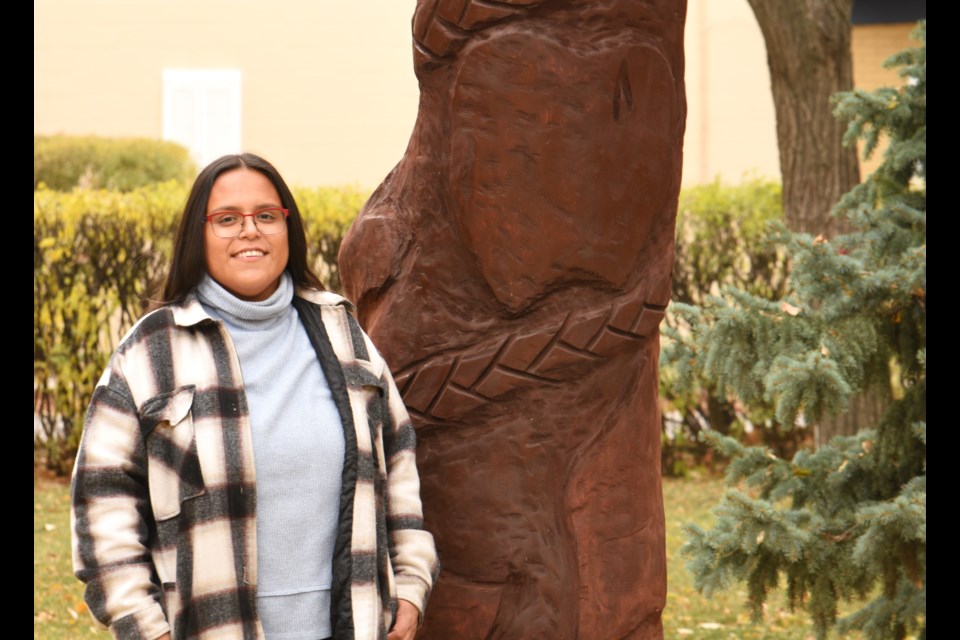MOOSE JAW — The Crescent Park Foundation announced the completion of the 2024 Tree Art Project in Crescent Park with a formal revealing in Moose Jaw’s historic park on Oct. 17.
This year’s artists include Karen Watson, creator of “Tribute to the Snowbirds,” Carly Jaye, creator of “Birds of Crescent Park,” and Sadi-Rose Vaxvick, creator of “Seven Sacred Grandfather Teachings.”
Each separate project supported by the foundation requires approval from the City of Moose Jaw and is then confirmed through a decision by the foundation’s board. Currently those board members include George Patterson, C.F. (Fred) Wigmore, Daily Lennox, Tom Pacy, Jim Dixon, Wendy Gilroy, Gwen Fisher, and Barry Seaborn.
The Crescent Park Foundation was founded in 1971 by the late Dr. Gerald Parkins and Mr. Geoff Hawkins. Through consulting with mutual friends, the two residents developed the idea of a fund whose income will be used to enhance Crescent Park’s amenities.
The foundation’s first major project was funded through a $10,500 grant from the Saskatchewan Heritage Fund. This initial project was the construction o the park entrance at the intersection of Langdon Crescent and Fairford Street East. The project ties back to Moose Jaw’s history through the incorporation of a stone archway which originally stood at an entrance of the former King Edward School.
The latest carving revealed on Oct. 17 was titled “The Seven Sacred Grandfather Teachings” and was created over a 24-hour period by local artist Sadi-Rose Vaxvick. The carving was made with a grinder and wood carving attachment and was finished in dark brown stain.
“I decided to create ‘The Seven Sacred Grandfather Teachings’ from the Plains (Cree) view of storytelling,” Vaxvick explained. “I am Plains Cree (Nêhiyaw) and Saulteaux and I’m just reconnecting back with my Indigenous heritage.”
The incorporation of sweetgrass speaks to the past, present, and future of Crescent Park and also symbolizes the eternal teachings of the seven sacred grandfathers.
“They (the foundation) wanted the past, present, and future of Crescent Park (represented),” she said. “I see and smell sweetgrass throughout Crescent Park and along the Wakamow Valley, and that’s always been there in the past, the present, and it’ll always stay in the future.”
The colour brown, she said, is meant to reflect a connection to the ground where the tree itself originated.
Vaxvick decided on her subject after learning about her heritage at the First Nations University in Regina and graduating from the school’s fine arts program last year. She said the meaning behind the sculpture is one of healing, and it incorporates all of the seven sacred animals and the meanings they bring. The top of the carving is meant to represent the Creator, who would have brought down all the sacred medicines and teachings, she said.
“The sculpture (is) meant to be healing,” she said. “I hope that when Indigenous peoples do come (here to the park), they get a sense of that feeling and vibe from it. When they do learn more about their culture or whatever they want to associate from that, it brings them back to their Indigenous ancestry, their culture, and just the way of life and the teachings that are brought along with it.”
Vaxvick’s portfolio and information about her new business, Mihkakwaniy by Sadi-Rose Vaxvick, can be viewed at SadiRoseVaxvick.ca.
Carly Jaye’s website and portfolio can be viewed at CarlyJaye.com. You can learn about Karen Watson and the other artists behind Crescent Park’s tree art projects at MJMAG.ca/Public-Art.
The project was possible thanks to the generous support of L&I Electric, Tip Top Roofing, Clark’s Supply, Elite Coating Systems Inc., the City of Moose Jaw parks and recreation facilities staff and Christy Schweiger, and the Moose Jaw Museum & Art Gallery.
To learn more about the Crescent Park Foundation Inc., email [email protected] or directly contact any member of the foundation. All donations made to the foundation are tax deductible.




